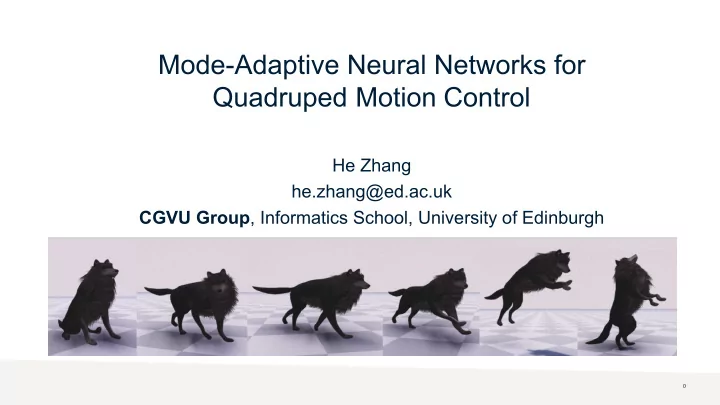

Mode-Adaptive Neural Networks for Quadruped Motion Control He Zhang he.zhang@ed.ac.uk CGVU Group , Informatics School, University of Edinburgh 0
OUTLINE • Research Background. • Related Works. • Mode-Adaptive Neural Networks. • Discussion and Summary. 1
RESEARCH GOAL(1) • Building interactive character controllers. • Synthesizing realistic and smooth character motions in real-time. Control System Example of character control 2 [Holden et al '17]
RESEARCH GOAL(2) • Learn from a large data set: – Wide range of motions. – Small memory. – Fast in execution time. 3
RELATED WORKS(1) DATA-DRIVEN CHARACTER CONTROLLERS • Classic techniques: walk run – Motion Graph [Kovar et al. 2002] [Lee et al. 2002] etc. – Motion Field [Lee et al. 2010] transitions – Motion Matching [Clavet 2016] Structure of Motion Graph – Repeat motion clips, e.g. repeat walking cycle/ running cycle. – Interpolate to get the transitions, e.g. interpolate between walking and running to get transitions. 4
RELATED WORKS(1) DATA-DRIVEN CHARACTER CONTROLLERS • Classic techniques: – Motion Graph [Kovar et al. 2002] [Lee et al. 2002] etc. – Motion Field [Lee et al. 2010] – Motion Matching [Clavet 2016] Structure of Motion Field – Search for K-Nearest poses for current pose from database. – Choose/blend from K-NN poses to get the next pose which satisfies user command best. – Using tricky structure for better searching, e.g. K-D trees. 5
RELATED WORKS(1) DATA-DRIVEN CHARACTER CONTROLLERS • Classic techniques: – Motion Graph [Kovar et al. 2002] [Lee et al. 2002] etc. – Motion Field [Lee et al. 2010] – Motion Matching [Clavet 2016] • Issues: – Require storing full motion database. – Require manual processing by artist, i.e. segmentation, labeling, mapping. – Require tricky structures (e.g.K-D trees) 6
RELATED WORKS(2) DATA-DRIVEN CHARACTER CONTROLLERS • Can Neural Networks Help? 𝑔 – Function Approximator ( 𝑔 ) 𝑦 𝑧 • Advantage – Learn from large dataset. – Fast runtime / Low memory usage. Example of Feed-Forward Neural Network 7
RELATED WORKS(2) DATA-DRIVEN CHARACTER CONTROLLERS • Convolutional Neural Networks [Holden et al. 2016] – Learning a mapping from a user control signal to a motion. 8
RELATED WORKS(2) DATA-DRIVEN CHARACTER CONTROLLERS • Convolutional Neural Networks [Holden et al. 2016] • Issues – Ambiguous mapping between input and output. – Whole input trajectory must be given beforehand. Issues of Floating caused by ambiguity – Muti-layer CNNs are still too slow. Same input trajectory can be mapped to different output 9
RELATED WORKS(2) DATA-DRIVEN CHARACTER CONTROLLERS • Recurrent Neural Networks [Fragkiadaki et al. 2015] – Mapping from the previous frame(s) to next frame. 10
RELATED WORKS(2) DATA-DRIVEN CHARACTER CONTROLLERS • Recurrent Neural Networks [Fragkiadaki et al. 2015] • Issues – Converge to average pose after ~10 seconds. – Difficult to avoid ”floating”. – Still has issues of ambiguity. Issues of ‘floating’ still occurs in RNN model 11
RELATED WORKS(2) DATA-DRIVEN CHARACTER CONTROLLERS • Phase-functioned Neural Network [Holden et al. 2016] – Phase is introduced to segment the motion cycle. -4 control points -4 neural networks 12
RELATED WORKS(2) DATA-DRIVEN CHARACTER CONTROLLERS • Phase-functioned Neural Network [Holden et al. 2016] – Phase is introduced to segment the motion. -4 control points -4 neural networks -current network weights -linear blended by adjacent control points 13
RELATED WORKS(2) DATA-DRIVEN CHARACTER CONTROLLERS • Phase-functioned Neural Network [Holden et al. 2016] Model structure of PFNN 14
RELATED WORKS(2) DATA-DRIVEN CHARACTER CONTROLLERS • Phase-functioned Neural Network [Holden et al. 2016] • Advantage of Phase – The pose of character is less ambiguous. – The space of poses is smaller and more convex. No floating issue in PFNN 15
RELATED WORKS(2) DATA-DRIVEN CHARACTER CONTROLLERS • Negative of PFNN – Require phase labels. – Cannot handle non-cyclic motions well. • Problems for quadruped motion capture data – Multi-modes and several actions. – Data are unstructured. – Non-cyclic motion, e.g. sitting, lying Quadruped motion capture data 16
MODE-ADAPTIVE NEURAL NETWORK OUTLINE • Model Structure. • Parameterization. • Training. 17
MODE-ADAPTIVE NEURAL NETWORK MODEL STRUCTURE Gating Network Motion Prediction Network Feed-Forward Network Feed-Forward Network 2 hidden layers 2 hidden layers 32 hidden units per layer 512 hidden units per layer elu, soft-max activation elu activation 18
MODE-ADAPTIVE NEURAL NETWORK MODEL STRUCTURE Experts Blending: 19
MODE-ADAPTIVE NEURAL NETWORK PARAMETERIZATION Input of System/Motion Prediction Network: • Motion at previous frame. • Trajectory at previous frame. 20
MODE-ADAPTIVE NEURAL NETWORK PARAMETERIZATION Action Control: • 6 action signals which is labeled by one-hot vector. • Target velocities control transitions between different gaits. Action labeling 21
MODE-ADAPTIVE NEURAL NETWORK PARAMETERIZATION Input of Gating Network(Motion Features): • Feet Joint Velocities at previous frame. • Target Velocities at previous frame. • Action Variables at previous frame. 22
MODE-ADAPTIVE NEURAL NETWORK PARAMETERIZATION Output of System/Motion Prediction Network: • Motion at current frame • Predicted Trajectory at current frame – for smooth transitions 23
MODE-ADAPTIVE NEURAL NETWORK TRANING • Cost function: – Mean square error between the predicted error and the ground truth: • Optimizer: – Stochastic gradient descent, AdamWR [Loshchilov and Hutter 2017] • Training Time – 20/30 hours with 4/8 experts, respectively, using NVIDIA GeForce GTX 970 GPU 24
MODE-ADAPTIVE NEURAL NETWORK RESULT • Compare with Standard NN and PFNN – Same number of layers and units. 25
MODE-ADAPTIVE NEURAL NETWORK RESULT • What do the different experts learn? – Different modes corresponds to different combination of experts. – Some experts have learned features which are specifically responsible for certain motions/actions. 26
MODE-ADAPTIVE NEURAL NETWORK DISCUSSION • Positive – No phase label needed – Can produce various high-quality locomotion modes – Can produce non-cyclic motions • Negative – Training time – Artistic control • Difficult to edit the outcome 27
MODE-ADAPTIVE NEURAL NETWORK SUMMARY • A novel time-series architecture to learn from a large unstructured quadruped motion capture dataset • Allow the user to interactively control the velocity, direction and actions. • End-to-end training without providing phase and gait labeling • Project - https://github.com/ShikamaruZhang/AI4Animation 28
Q & A 29
Recommend
More recommend